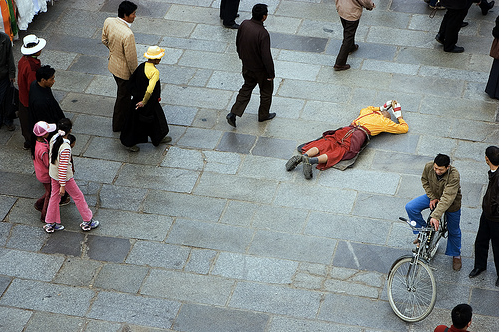--Prophet Muhammad
Fig. 1 A two-year-old can understand this. Someone fetch me a two-year-old!
Listening to a Speaking of Faith podcast from a few years ago, I was struck today by Ingrid Mattson’s description of her first prostration experience. This particular episode is an interview with Ingrid regarding her conversion to Islam and subsequent appointment as the first woman president of ISNA, the Islamic Society of North America.
Ingrid tells the story of being in France during her first exposure to Senegalese Muslim devotees who became her friends. One day, they invited her to pray with them and she said she didn’t know how. They said that she could just follow along with what they were doing, so she obliged. Islamic prayer, the du'a, involves many steps, including several body positions and prescribed chants and Ingrid felt extremely awkward trying to keep up.
Fig. 2 I'm pretty sure it's not quite this complicated
But once she had her forehead to the ground, taking pause in that position, she felt closer to the earth, closer to God, and in the intimacy of the moment in which she could not be distracted simply because her eyes are staring at the floor, she felt prayer as a full body experience for the first time. When I heard her say that, I remembered that I had the exact same feelings doing my first Buddhist prostration.
I don’t know about y’all, but the last time I had my forehead to the ground was last night, after dinner. My pre-yoga ritual consists of what may be called a standard Buddhist chant:
I take refuge in the Buddha.
I take refuge in the Dharma.
I take refuge in the Sangha.
I follow this up with candle-lighting and some prostrations of my own, borrowed from the Tibetans. I hold my palms together in a specific mudra (hand formation) and touch the top of my head, my forehead, my heart, and then bend down for a full-body prostration on the ground, touching my forehead to the carpet. I do this three times, each time reciting the above mantra.
Fig. 3 Olympic Cross-country prostration
When I did this for the first time, I was in the privacy of my bedroom, with nothing to distract me and no one to see me make this new step toward adopting a cultural tchotchke my new faith. It felt incredibly strange and awkward. As a not-so-churchy person to start with, when I saw movies and documentaries showing Buddhists doing this pretty obvious, involved, anti-subtle prayer ritual, I was confused. I had to keep in mind that it was a Tibetan-style prostration, one full of meaning and metaphor and even superstitious history, but it was beautiful and I wanted in.
I wanted to “create sacred space” and learn to respect it by bookending my meditations and yoga practices with a small ritual.
But the prostrations were awkward for more than one reason, i.e. I had no clue what I was doing because I had never done them before. It was strange because bowing and touching the floor, in Western society, is associated with subservience and is way too self-deprecating an act for a middle-class protestant nation that worked very hard to escape class-obsessed systems and aristocratic societal structure.
For Eastern societies, these acts are a sign of profound respect toward someone or something and in no way demeans the person doing them. It is humbling, but it’s a willful humility I adopt whenever expressing my respect for my teacher, The Buddha. I bow to him, not as a worshipper, but as a student, and in the process, I also bow to nature and the Universe, connecting myself to a stable ground beneath me through a gentle touch that always touches me back.
I definitely fulfill my quota of hours with my head in the clouds (and especially in outer space due to my love of astronomy), so it's common sense to balance it out by literally touching it down to the ground everyday.










No comments:
Post a Comment
You're welcome to comment. Just keep in mind this is a personal as well as an academic blog and I like to see thoughtful, respectful commentary. No offensive language or curt replies, please :)